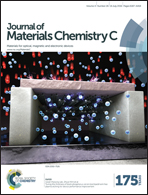Room temperature dielectric bistability in solution-processed spin crossover polymer thin films†
Abstract
The spin crossover (SCO) phenomena are a remarkable example of spin-state switching at the molecular level. The low- and high-spin states can be reversibly selected through application of external stimulus – often simply a variation in temperature. Since the particular spin-state embodies optical, electronic and structural characteristics, the spin switching can be readily detected or probed using a variety of techniques. In this regard, SCO phenomena show great promise for a range of devices. The key to this uptake is the preparation of high-quality, thin-films capable of retaining SCO properties, and solution-based materials, in particular, provide further opportunities for integration or blending with other functional materials. The present work examines SCO behaviour from two iron(II)–triazole polymers, with short and long side chains, prepared and investigated in a variety of formats – from bulk powders to thick and thin films. Magnetic, optical and electronic techniques all verify the SCO behaviour is faithfully maintained for all formats. The two materials serve to highlight the impact on key properties arising from the different density of Fe atoms. The results, all from solution-based materials, are extremely promising and clearly emphasise the growing capabilities and processing advances associated with SCO compounds.


 Please wait while we load your content...
Please wait while we load your content...